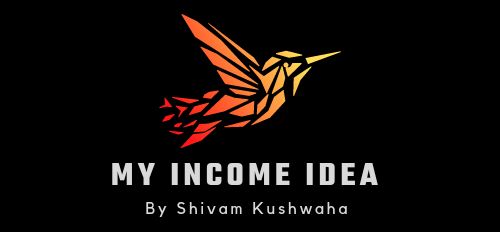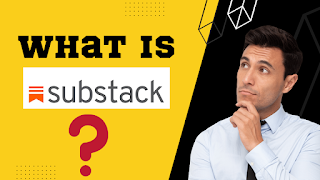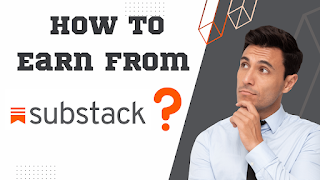What is substack?
Substack is a platform for writers and journalists to publish and monetize their work. It allows writers to create their own newsletters and charge subscribers a fee to access their content.
Substack was founded in 2017 and has become a popular platform for independent writers, particularly those in the tech and media industries. It allows writers to have control over their own content and directly monetize their work, rather than relying on advertising or traditional publishing routes.
Substack also offers tools and support for writers to grow their audience and build a community around their work. It is currently available in over 190 countries and supports multiple languages.
How to make money from Substack?
There are several ways to make money from Substack:
Charge a subscription fee: Writers can create a newsletter and set a subscription fee for readers to access their content. They can offer different subscription tiers or discounts for long-term subscriptions.
Offer paid content: Writers can create exclusive content that is only available to paying subscribers. They can also offer discounts or special perks to subscribers.
Sell merchandise: Writers can sell merchandise such as t-shirts, mugs, or other items through their Substack account.
Offer services: Writers can offer services such as consulting, coaching, or editing to their subscribers.
Run sponsored content: Writers can run sponsored content or sponsored newsletters for businesses or organizations.
How does Substack work for writers?
Substack is a platform that allows writers to publish and monetize their work through newsletters. Here's how it works for writers:
Writers create a Substack account and set up their own newsletter. They can choose a name and design for their newsletter and start publishing content.
Writers can publish any type of content, including articles, essays, podcasts, or videos. They can also create exclusive content that is only available to paying subscribers.
Writers can set their own subscription fee for readers to access their content. Substack offers different pricing options and allows writers to offer discounts or special perks to subscribers.
Writers can also sell merchandise or offer services through their Substack account, such as consulting or coaching.
Substack handles distribution and marketing for writers, making it easy for them to reach a wider audience. Writers can also use Substack's tools and support to grow their audience and build a community around their work.
What tools does Substack offer for writers to grow their audience and monetize their work?
Substack offers a range of tools and support for writers to grow their audience and monetize their work:
Customizable newsletters: Writers can design and customize their own newsletters to match their brand and style.
Marketing and distribution: Substack handles distribution and marketing for writers, making it easy for them to reach a wider audience. They also offer tools and support for writers to grow their audience and build a community around their work.
Subscription options: Writers can set their own subscription fee and offer different pricing tiers or discounts for long-term subscriptions. They can also offer paid content or special perks to subscribers.
Merchandise sales: Writers can sell merchandise such as t-shirts, mugs, or other items through their Substack account.
Services: Writers can offer services such as consulting, coaching, or editing to their subscribers.
Sponsored content: Writers can run sponsored content or sponsored newsletters for businesses or organizations.
Can writers use Substack to publish any type of content, or are there specific categories or topics that are preferred?
Writers can use Substack to publish any type of content, including articles, essays, podcasts, videos, or other formats. There are no specific categories or topics that are preferred or required on Substack.
However, writers should keep in mind that the success of their newsletter will depend on the quality and relevance of their content, as well as their ability to build an engaged and loyal audience.
It is important for writers to choose a focus or theme for their newsletter and consistently produce high-quality content that resonates with their audience. This can help writers build a loyal following and increase their chances of success on Substack.
What are some tips to get more engagement?
Here are some tips to get more engagement on Substack:
Write high-quality content: The most important factor in getting more engagement is to produce high-quality, relevant content that resonates with your audience. This means putting in the time and effort to research, write, and edit your content to ensure that it is of the highest quality.
Use effective headlines: A good headline can make a big difference in getting more engagement. Use headlines that are clear, concise, and compelling to grab the attention of your readers.
Engage with your audience: Building a community around your work is key to getting more engagement. Respond to comments and messages from your readers, and encourage them to engage with your content by asking for their thoughts or feedback.
Promote your content: Share your content on social media and other platforms to reach a wider audience. You can also use email marketing or other tactics to promote your content and encourage more people to subscribe.
Experiment with different formats: Try out different formats, such as articles, podcasts, or videos, to see what works best for your audience. This can help you find the format that resonates the most with your readers and gets the most engagement.
How do writers set up a subscription fee on Substack and what options are available for payment?
To set up a subscription fee on Substack, writers will need to follow these steps:
- Create a Substack account: Writers will need to sign up for a Substack account and create a newsletter.
- Choose a subscription model: Substack offers two subscription models for writers: pay-per-issue or pay-per-month.
- Pay-per-issue: Writers can set a price for each individual issue of their newsletter. This allows readers to pay for only the issues they want to access.
- Pay-per-month: Writers can set a monthly subscription fee for access to all of their content. This option allows writers to offer a discount for long-term subscribers.
- Set the subscription fee: Writers can choose the amount they want to charge for their newsletter. Substack recommends setting a price between $5 and $50 per month, depending on the quality and value of the content.
- Choose payment options: Substack offers several payment options for writers, including Stripe, PayPal, and Apple Pay. Writers can choose one or more payment options to offer to their subscribers.
How do I use Substack as a reader?
To use Substack as a reader, you will need to follow these steps:
Go to the Substack website: Visit substack.com and browse the available newsletters.
Find a newsletter you are interested in: You can use the search function or browse the categories to find newsletters that match your interests.
Subscribe to the newsletter: Click on the newsletter you are interested in and click the "Subscribe" button. You will be prompted to enter your email address and choose a subscription plan.
Choose a payment method: Substack offers several payment options, including Stripe, PayPal, and Apple Pay. Choose the payment method you prefer and complete the payment process.
Start reading: Once you have completed the subscription process, you will receive updates and new content from the newsletter in your email inbox. You can also access the content through the Substack website or app.
How does Substack make money?
Substack makes money by charging a percentage of the subscription fees collected by writers. When a writer sets up a subscription fee for their newsletter, Substack takes a percentage of the revenue as their fee.
Substack also makes money through its Substack Pro service, which offers additional tools and support for writers to grow their audience and monetize their work. Writers can choose to upgrade to Substack Pro for a fee.
Overall, Substack's revenue is generated through a combination of subscription fees and its Pro service, which helps writers grow and monetize their newsletters.
Substack vs Medium which is better?
It is difficult to say definitively which platform is better, as it will depend on the individual needs and goals of the writer. Here are some key differences between Substack and Medium:
Monetization: Substack allows writers to set their own subscription fees and directly monetize their work. Medium does not offer a subscription model, but allows writers to earn money through the Medium Partner Program, which pays writers based on the number of views their articles receive.
Audience: Substack has a smaller, more focused audience compared to Medium. This can be both an advantage and a disadvantage, depending on the writer's goals. Substack may be better for writers who want to build a loyal, dedicated following, while Medium may be better for writers who want to reach a wider, more general audience.
Control: Substack gives writers more control over their content and brand, as they can customize their newsletters and set their own subscription fees. Medium is more of a publishing platform, and writers do not have as much control over their content and brand.
Ultimately, the decision of which platform is better will depend on the individual needs and goals of the writer. Both Substack and Medium have their own pros and cons, and writers should consider their own priorities and preferences when choosing a platform.
Who are some most popular Substack writers ?
Some of the most popular Substack writers include:
Andrew Sullivan: Andrew Sullivan is a political commentator and journalist who has over 50,000 subscribers to his Substack newsletter, "The Dish." He covers a range of topics, including politics, culture, and media.
Matt Taibbi: Matt Taibbi is a journalist and author who has over 50,000 subscribers to his Substack newsletter, "Taibblog." He covers topics such as politics, media, and economics, and is known for his investigative reporting and controversial opinions.
Ben Thompson: Ben Thompson is a technology and media analyst who has over 40,000 subscribers to his Substack newsletter, "Stratechery." He covers topics such as technology, media, and business, and is known for his in-depth analysis and insights.
Aaron Sorkin: Aaron Sorkin is a screenwriter, producer, and director who has over 30,000 subscribers to his Substack newsletter, "The West Wing Weekly." He covers topics such as politics, media, and entertainment, and is known for his work on popular TV shows and films.
Scott Alexander: Scott Alexander is a psychiatrist and writer who has over 30,000 subscribers to his Substack newsletter, "Slate Star Codex." He covers a wide range of topics, including psychology, politics, and science, and is known for his thought-provoking and controversial opinions.
Are there any success stories or case studies of writers who have made significant income through Substack?
Yes, there are many success stories and case studies of writers who have made significant income through Substack. Here are a few examples:
Chris Evans: Chris Evans is a technology journalist who has made over $500,000 through his Substack newsletter, "The Tech wonk." He shares his insights and analysis on technology and media, and has built a loyal following of over 8,000 subscribers.
Sarah Drasner: Sarah Drasner is a web developer and designer who has made over $300,000 through her Substack newsletter, "Web Designer News." She shares her expertise and insights on web design and development, and has built a community of over 4,000 subscribers.
Christina Cauterucci: Christina Cauterucci is a journalist who has made over $200,000 through her Substack newsletter, "Slate Plus." She covers topics such as politics, culture, and media, and has built a following of over 10,000 subscribers.
I hope this article was helpful to you. If you need help let me know in comment section below.


